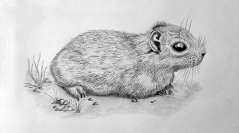

 Comptes Rendus Palevol
23 (20) - Pages 269-292
Comptes Rendus Palevol
23 (20) - Pages 269-292The understanding of the taxonomy, diversity, and evolutionary patterns of caviids in northwestern Argentina is still in the process of development. This paper presents new insights into the systematic and evolution of Orthomyctera andina (Rovereto, 1914), one of the most abundant species within Caviidae Fischer de Waldheim, 1817, in the fossil record of this region. A comprehensive anatomical description and taxonomic review of Orthomyctera andina in a phylogenetic context is provided. Moreover, it includes a redescription of the type specimen of Orthomyctera rigens (Ameghino, 1888). The taxonomical results confirm that O. andina belongs to a different genus: Orocavia (Kraglievich, 1932). The phylogenetic analysis further confirms the placement of both species within Caviinae Fischer de Waldheim, 1817. Orthomyctera andina is the sister taxon of the clade that includes Microcavia Gervais & Ameghino, 1880, Dolicavia Ameghino, 1916, Neocavia Kraglievich, 1932, and Orthomyctera Ameghino, 1889. It is supported by a combination of plesiomorphic characters (e.g. furrow opposite to hypoflexus/id in molariforms) shared with basal taxa and Dolichotinae Pocock, 1922 and derived characters (such as a terreced palate, external auditory meatus below the occlusal surface , length of p4-m1 shorter than length of m2-m3) shared with Caviinae. This study aims to elucidate the taxonomic status of these poorly known rodents and their relationships within Caviidae. Additionally, it incorporates a biogeographic analysis of caviomorph communities from the late Neogene in Argentina.
Caviinae, taxonomy, phylogeny, diversity, Miocene-Pliocene, South America, new combination